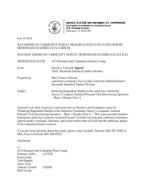Reducing Respondent Burden in the American Community Survey's Computer Assisted Personal Visit Interviewing Operation - Phase 1 Results (Part 1)
Reducing Respondent Burden in the American Community Survey's Computer Assisted Personal Visit Interviewing Operation - Phase 1 Results (Part 1)
There are many ways through which people communicate with each other and some people may prefer one mode over another to stay in touch with the world around them. This ability to be constantly connected can sometimes be overwhelming. Multimode surveys, such as the American Community Survey (ACS), try to find a balance between taking advantage of a variety of contact modes and strategies, and limiting respondent burden. From its inception through 2012, the ACS used a three-month sequential contact strategy to obtain responses from sampled addresses. In the first month, multiple mailings were sent to sampled addresses (i.e. pre - notice letter, paper questionnaire, reminder postcard, and, to those addresses that did not respond by a certain cut - off date, a replacement paper questionnaire). Addresses that did not provide a response by the end of the first month, and for which we had a valid phone number, were contacted using Computer - Assisted Telephone Interviewing (CATI). At the end of the second month, nonresponding addresses were subsampled and sent to Computer - Assisted Personal Interviewing (CAPI). This sequential, multimode approach can lead to a cumulative number of contacts that may be perceived by some to be harassment.
Criticism from external stakeholders about this perception of harassment provided motivation for research into the respondent burden associated with repeated contact attempts of house holds in the ACS interviewer - administered modes, CATI and CAPI. The research discussed in this report focuses on the CAPI mode. For results from the CATI research, see Griffin and Hughes (2013) and Zelenak and Davis (2013).
Others in Series
Working Paper
Working Paper
Working Paper




